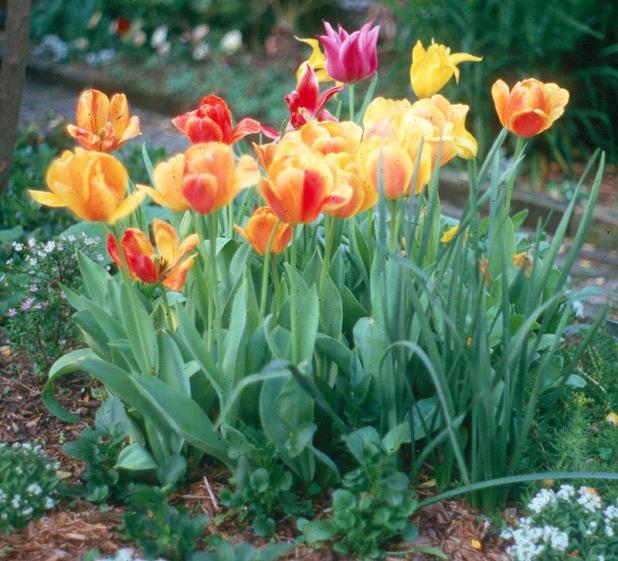
Tulip variegation is often caused by a virus.
—LSU AgCenter file photo/Dan Gill
Get It Growing: Nature, gardening are full of surprises
Both nature and gardening are full of surprises. Have you ever seen a flowering shrub that has two completely different flower colors on the same plant? Or have you noticed that a portion of your plants’ variegated leaves are now solid green or a different shape all together? Strange changes in plants can be rationally explained if we dig a little deeper.
Some of these surprises stem from the way plants were bred and produced. Plant breeding has been practiced since the dawn of human civilization, starting with agriculture more than 10,000 years ago. Agriculture is the science and practice of farming, including the cultivation of crops and animals for food. Agriculture is thought to have been established with the domestication of cereal grains such as wheat when humans recognized superior plant qualities and began saving seeds.
Plant breeding has come a long way since the start of agriculture. Humans branched out beyond food crops to ornamental plants that enhance and create unique landscapes.
Ornamental plant breeders cultivate plants that have desirable characteristics such as larger flowers, extended bloom times, repeat blooms, unique flower colors, variegated foliage and increased flower production. Disease and pest resistance, in addition to drought tolerance, are additional traits selected for by breeders.
There are several techniques plant breeders use to enhance plants. Hybridization is the practice of bringing together desirable traits from two different plant varieties through cross-pollination to produce a new plant with distinct characteristics. One great example of this is in flowering ornamental plants, including bedding plants and flowering shrubs and trees.
Plants also can have genetic changes or mutations that produce a unique characteristic that we find striking. These mutations are often referred to as “sports,” and breeders will take cuttings of them to develop new cultivars that will retain those unique characteristics. Variegated plants are often selected this way.
The variation in color is often just the absence of the green pigment (chlorophyll) in some of the plant cells. This can be the result of a cell mutation, or it can be a genetically inherited trait that is passed down to offspring. A genetic trait is stable, while random mutations are unstable.
The variegation mutations are an anomaly of nature. Plant breeders see these mutations as something beautiful and then clone the plants to produce more plants with those specific traits. This also can happen in reverse when you observe a plant that once displayed foliage of several colors but has reverted to full green, single-colored foliage. These are both naturally occurring mishaps of nature.
Variegation also can be the result of viral infections. Yes, when the plant becomes infected with certain viruses, it can cause symptoms that result in two-toned coloring (foliar mosaic) that gives it a distinctive pattern, or the veins of the plant will turn yellow or lose green coloring between the veins. The leaf may become curled, causing a malformation, or the plant could be stunted in growth (dwarf). These characteristics can be attractive to breeders, even though they were caused by a virus.
Some growers have tapped into this tool of utilizing viruses to manipulate the physical appearance of plants. One example is tulip-breaking virus, which was used in the early 17th century by Danish growers to force beautiful flower variegation. The variegated tulip flowers increased the commercial value of the crop tremendously, and this was certainly an economic benefit.
Reversion of variegation also can be seen in variegated flowers. An example of this is the floribunda rose Hocus Pocus that is a sport of the dark red hybrid tea rose known as Black Beauty. Hocus Pocus can be genetically unstable and sometimes produces dark red roses alongside the striped blossoms, reverting back to the characteristic traits of its parent plant.
Once a plant reverts to its original characteristics, it will no longer be able to produce variegation. Those reverted portions of the plant can be removed by pruning to keep the plant uniform, if you wish. Alternatively, embrace those natural surprises — they are beautiful in their own unique way.
